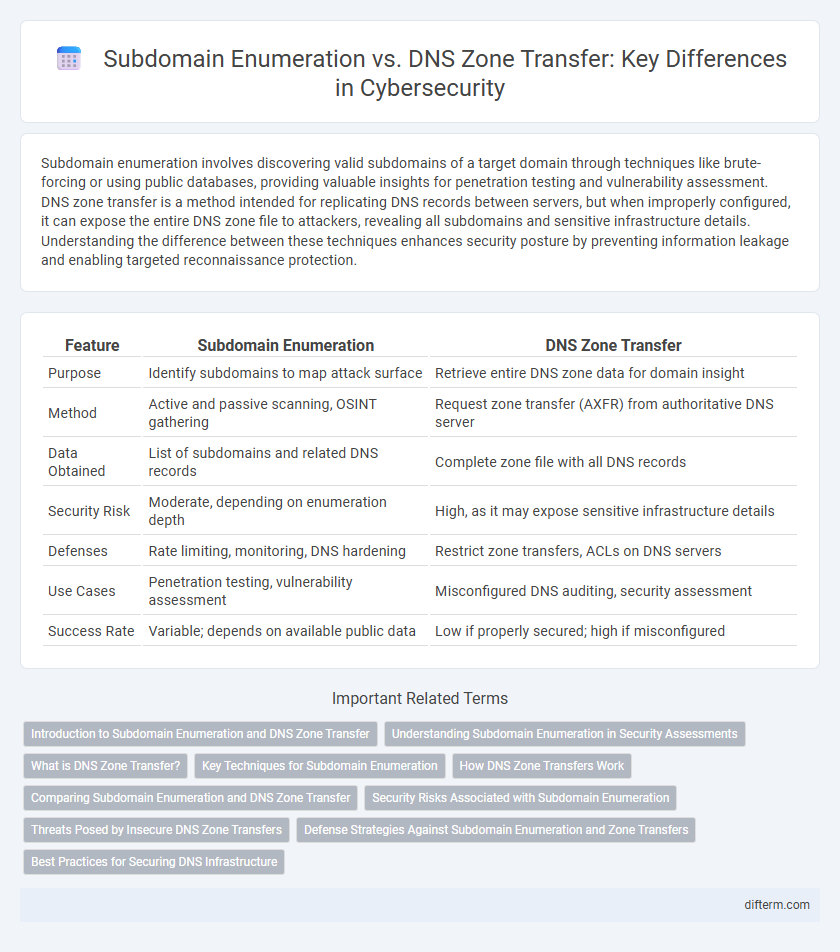Subdomain enumeration involves discovering valid subdomains of a target domain through techniques like brute-forcing or using public databases, providing valuable insights for penetration testing and vulnerability assessment. DNS zone transfer is a method intended for replicating DNS records between servers, but when improperly configured, it can expose the entire DNS zone file to attackers, revealing all subdomains and sensitive infrastructure details. Understanding the difference between these techniques enhances security posture by preventing information leakage and enabling targeted reconnaissance protection.
Table of Comparison
| Feature | Subdomain Enumeration | DNS Zone Transfer |
|---|---|---|
| Purpose | Identify subdomains to map attack surface | Retrieve entire DNS zone data for domain insight |
| Method | Active and passive scanning, OSINT gathering | Request zone transfer (AXFR) from authoritative DNS server |
| Data Obtained | List of subdomains and related DNS records | Complete zone file with all DNS records |
| Security Risk | Moderate, depending on enumeration depth | High, as it may expose sensitive infrastructure details |
| Defenses | Rate limiting, monitoring, DNS hardening | Restrict zone transfers, ACLs on DNS servers |
| Use Cases | Penetration testing, vulnerability assessment | Misconfigured DNS auditing, security assessment |
| Success Rate | Variable; depends on available public data | Low if properly secured; high if misconfigured |
Introduction to Subdomain Enumeration and DNS Zone Transfer
Subdomain enumeration identifies all active subdomains within a target domain to discover potential attack surfaces and vulnerabilities. DNS zone transfer involves copying the DNS zone file from a primary to a secondary server, which if misconfigured, exposes sensitive DNS records and network infrastructure details. Both techniques are fundamental in security assessments for mapping domain structures and detecting misconfigurations.
Understanding Subdomain Enumeration in Security Assessments
Subdomain enumeration is a critical technique in security assessments used to identify all subdomains associated with a target domain, revealing potential attack vectors and hidden assets. It leverages DNS queries, brute force, and open-source intelligence to map the attack surface without requiring privileged access. Unlike DNS zone transfers, which involve requesting a full copy of the DNS zone data and often fail due to misconfigurations, subdomain enumeration is a stealthier and more widely applicable method to gather domain-related information.
What is DNS Zone Transfer?
DNS Zone Transfer is a mechanism that allows the replication of DNS database information from a primary DNS server to a secondary server, ensuring consistency and redundancy. It is primarily used for synchronizing DNS records across multiple servers within the same zone. Misconfigured DNS Zone Transfers can expose sensitive DNS data, making them a critical aspect of DNS security assessments.
Key Techniques for Subdomain Enumeration
Key techniques for subdomain enumeration include DNS brute forcing, leveraging OSINT (Open Source Intelligence) sources, and utilizing tools like Sublist3r and Amass to identify potential subdomains. Passive DNS data collection and reverse DNS lookups enhance the discovery process without alerting the target infrastructure. Unlike DNS zone transfers, which attempt to retrieve the entire DNS zone file and often fail due to security restrictions, subdomain enumeration focuses on granular identification of subdomains through diversified, stealthy methods.
How DNS Zone Transfers Work
DNS Zone Transfers operate by copying the DNS data from a primary server to secondary servers, ensuring synchronization across the DNS infrastructure. The process involves a secondary server sending a request to the primary server for the complete zone file, which contains all DNS records. Properly configured DNS servers restrict zone transfers to authorized IP addresses to prevent attackers from obtaining sensitive domain information.
Comparing Subdomain Enumeration and DNS Zone Transfer
Subdomain enumeration involves discovering subdomains associated with a primary domain, often through passive methods like querying public databases and active techniques such as brute-forcing DNS records. DNS zone transfer is a mechanism intended for replicating DNS zone data between servers but can become a critical security risk if misconfigured, allowing an attacker to retrieve the entire DNS zone file. Compared to DNS zone transfer, subdomain enumeration is generally more limited in scope but harder to detect, while DNS zone transfer can provide comprehensive DNS information if exploited.
Security Risks Associated with Subdomain Enumeration
Subdomain enumeration exposes an organization to significant security risks by revealing potentially sensitive subdomains that attackers can target for vulnerabilities, phishing, or unauthorized access. Unlike DNS zone transfers, which require misconfigured servers to leak detailed DNS information, subdomain enumeration leverages public sources and brute-force methods, making it a more stealthy and widespread reconnaissance technique. Identifying exposed subdomains aids attackers in mapping the attack surface, increasing the likelihood of exploitation and data breaches.
Threats Posed by Insecure DNS Zone Transfers
Insecure DNS zone transfers expose critical network infrastructure by allowing attackers to replicate the entire DNS database, revealing all subdomains and internal hostnames. This information aids in targeted cyberattacks, including phishing, malware distribution, and network reconnaissance, significantly increasing the threat landscape. Unlike subdomain enumeration, which relies on public data, DNS zone transfer vulnerabilities provide a comprehensive and accurate view of the domain's structure, making them a high-risk security flaw.
Defense Strategies Against Subdomain Enumeration and Zone Transfers
Implementing strict DNS server access controls and disabling unnecessary zone transfers significantly reduces the risk of unauthorized data exposure. Utilizing security tools like DNSSEC helps validate DNS responses, mitigating subdomain enumeration attacks. Regularly auditing DNS configurations and monitoring for anomalous query patterns strengthens defense against both subdomain enumeration and DNS zone transfer exploits.
Best Practices for Securing DNS Infrastructure
Best practices for securing DNS infrastructure emphasize restricting DNS zone transfers to authorized IP addresses using Access Control Lists (ACLs) to prevent unauthorized subdomain enumeration. Implementing DNSSEC (Domain Name System Security Extensions) protects against data tampering and ensures the integrity of DNS responses, mitigating risks associated with zone transfer exploits. Regular auditing of DNS configurations and monitoring for unusual transfer requests are critical for maintaining robust subdomain security and detecting potential reconnaissance activities.
Subdomain Enumeration vs DNS Zone Transfer Infographic

 difterm.com
difterm.com